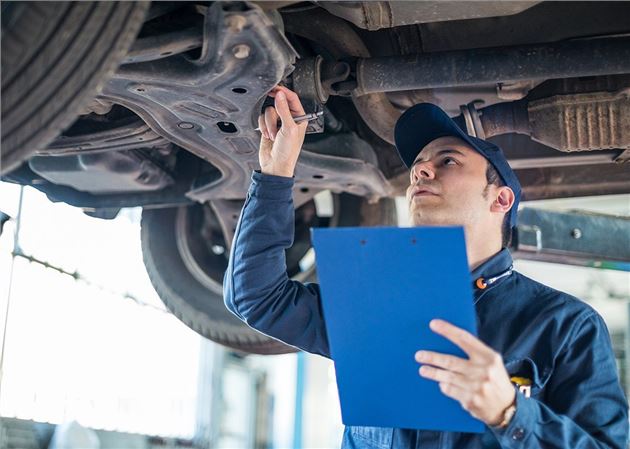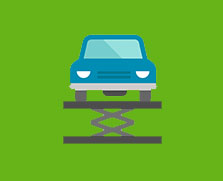MoT Test Results and MoT Advice

Third of MoT failures could be prevented if drivers made basic checks
Over 2.5 million MoT failures could be avoided every year if drivers checked their tyres, lights, brakes and windscreen, according to new research.
HonestJohn.co.uk analysed millions of MoT records from the Driver and Vehicle Standards Agency (DVSA) and found that, out of the 7.3 million MoT failures that were recorded in 2017, more 2.5 million could have been avoided if drivers had performed 10 basic checks to their vehicle.
The number one MoT fail is incorrect headlamp aim, with 976,569 failures. In second place is poor brake performance (921,534 failures) while broken registration plate lamps account for 912,246 failures.
Faulty side lights and insufficient tyre tread depth complete the top five, while thousands more cars are failed due to worn out windscreen wipers and missing screen wash.
Browse all MoT pass rates by make and model
Click below to find MoT pass rates by make and model and details on what your car is likely to fail its MoT test on, based on Government data. All makes and models up to 2014 are listed.
- Abarth
- Aixam
- Alfa Romeo
- Alpine
- Aston Martin
- Audi
- Austin
- Bedford
- Bentley
- BMW
- Cadillac
- Caterham
- Chevrolet
- Chrysler
- Citroen
- Dacia
- Daewoo
- Daihatsu
- Daimler
- Dodge
- DS
- Ferrari
- FIAT
- Ford
- Great Wall
- Honda
- Hyundai
- Infiniti
- Isuzu
- Jaguar
- Jeep
- Kia
- Lamborghini
- Lancia
- Land Rover
- Lexus
- Lotus
- LTI
- Maserati
- Mazda
- McLaren
- Mercedes-Benz
- MG
- Microcar
- MINI
- Mitsubishi
- Morgan
- Nissan
- Opel
- Perodua
- Peugeot
- Porsche
- Proton
- Reliant
- Renault
- Reva
- Rolls-Royce
- Rover
- SAAB
- Santana
- SEAT
- Skoda
- smart
- SsangYong
- Subaru
- Suzuki
- Talbot
- Tesla
- Toyota
- Triumph
- TVR
- Vauxhall
- Volkswagen
- Volvo

Porsche named best manufacturer when it comes to passing the MoT
Porsche is the best brand for passing the annual MoT according to the latest MoT Files. Eight out of every 10 tested for an MoT in 2017 passed, with the Cayman performing the best.
Dacia was second, just ahead of Lexus. The former was introduced into the UK 2013 and its youthful range of cars, they would only be going through their first or second MoT, explains the high pass rate.
Things are not quite so positive for Dacia's parent company Renault, which is once again propping up the table, not helped by low pass rates for ageing models from the 1990s and 2000s such as the Laguna and Espace. Meanwhile, only around half of all Megane models passed the annual test.
Not only is Renault's overall pass rate of just 52.6 per cent way below par, it lags behind even defunct brands such as Rover (54.2 per cent), Saab (59.5 per cent) and Chevrolet (60.2 per cent).
Renault wasn't alone with fellow French brands Peugeot and Citroen also featuring near the bottom of the table.
SsangYong is another manufacturer that disappoints. Despite coming top in the Honest John Satisfaction Index 2018, it has a lowly MoT pass rate of 59.6 per cent from just 7500 vehicles tested.
The two most popular brands in the UK also fell below the average pass rate with only six of every 10 Vauxhalls passing the MoT and Ford faring little better with a 65 per cent success rate.
| Manufacturer | Tests | Failures | Pass Rate |
| Porsche | 95,247 | 18,371 | 80.7% |
| Dacia | 32,967 | 6678 | 79.7% |
| Lexus | 102,622 | 24,035 | 76.6% |
| Audi | 985,861 | 251,614 | 74.5% |
| BMW | 942,080 | 253,044 | 73.1% |
| Skoda | 422,799 | 119,556 | 71.7% |
| DS | 74,219 | 21,667 | 70.8% |
| MINI | 468,757 | 137,303 | 70.7% |
| Hyundai | 456,935 | 134,528 | 70.6% |
| Toyota | 1,103,429 | 332,095 | 69.9% |
| Smart | 16,938 | 5143 | 69.6% |
| Mercedes-Benz | 471,476 |
143,440 | 69.6% |
| Kia | 419,614 | 128,944 | 69.3% |
| Land Rover | 579,132 |
179,684 | 69.0% |
| Honda | 814,282 | 253,595 | 68.9% |
| Jaguar | 226,960 | 71,032 | 68.7% |
| Mazda | 391,307 | 126,181 | 67.8% |
| Suzuki | 284,453 | 92,180 | 67.6% |
| SEAT | 317,233 | 103,422 | 67.4% |
| Subaru | 62,286 | 20,399 | 67.2% |
| Volkswagen | 1,870,042 | 619,190 | 66.9% |
| Nissan | 957,612 | 319,054 | 66.7% |
| Volvo | 374,276 | 131,378 | 64.9% |
| Ford | 3,144,861 | 1,105,500 | 64.8% |
| Jeep | 37,208 | 13,407 | 64.0% |
| Daihatsu | 28,636 | 10,351 | 63.9% |
| Mitsubishi | 170,766 | 62,129 | 63.6% |
| Alfa Romeo | 70,121 | 25,789 | 63.2% |
| Fiat | 486,556 | 179,101 | 63.2% |
| Vauxhall | 2,585,069 | 1,007,237 | 61.0% |
| Peugeot | 1,143,371 | 461,539 | 59.6% |
| SsangYong | 7560 | 3056 | 59.6% |
| Chevrolet | 97,274 | 39,407 | 59.5% |
| Citroen | 665,645 | 270,329 | 59.4% |
| SAAB | 112,192 | 45,572 | 59.4% |
| MG | 52,202 | 21,762 | 58.3% |
| Chrysler | 38,494 | 16,085 | 58.2% |
| Dodge | 10,557 | 4476 | 57.6% |
| Isuzu | 7789 | 3417 | 56.1% |
| Proton | 8847 | 3980 | 55.0% |
| Rover | 86,067 | 40,482 | 53.0% |
| Renault | 859,950 | 407,470 | 52.6% |
Top 20 cars for passing the MoT Test

Mercedes-Benz GLA - 93.1% pass rate
Launched in 2014, GLA owners would have had their first MoT in 2017 - and it's good news with 93.3 per cent passing. The GLA also does better than average at higher mileage, with a 92.5 per cent pass rate at 50k - 60k miles verses the 68.2 per cent average pass rate at that mileage.
Audi Q3 - 91.1% pass rate
More than 29,000 Q3s went for their MoT in 2017, with all but 2598 passing. Some 3.7 per cent failed on tyre issues, with 2.5 per cent failing on problems with the electrical equipment, lamps and reflectors. It's worth noting that the new Q3 made its debut in 2018, so the models listed here relate to the previous generation Q3.

Peugeot 108 - 90.3% pass rate
It's not the most popular or refined choice in the city car class, nor would we have guessed it'd land itself in third spot in this list, but the 108 is obviously doing something right. Of the 6427 that went for an MoT in 2017, 5805 passed - with (you guessed it) tyres being the biggest reason for failure.
Click here to see the top 20 cars for passing the MoT
What is the MoT and why is it so important?
The MoT test is a legally-required examination for all vehicles when they reach three years old, cars over three years are then tested every 12 months after that. The MoT test is used to determine if your vehicle is roadworthy, you also need a valid MoT certificate to tax and insure your car.
The Ministry of Transport test, or the MoT test as it's better known, was introduced in 1960. Road use in Britain boomed in the 1950s, with the number of cars leaping from five to 15-million in less than a decade. Poor safety standards let to a high number of road deaths, which resulted in the MoT test. The MoT test has come a long way since then, but it still isn't a fully comprehensive check.
Although the MoT test is the only legal requirement, it's also fairly basic. The MoT doesn't investigate a number of important, internal components - like the transmission and engine. So it's very important that your car is regularly serviced to ensure it's in good working order.
What does the MoT test involve?
The fuel system of the car is checked to make sure that it doesn't burn more fuel than it should. It also checks for leaks and blockages. The headlights and rear lights are also tested to make sure they all work and are aimed correctly.
All the brakes of the car go through checks to make sure that they are functioning properly and the car's emission levels are also checked. Controlling pollution levels is important and government regulations require vehicles to pass through emission level tests to ensure that they don't emit more pollution than specified.
Tyres with tread lower than 1.6mm are illegal and will cause your vehicle to fail the MoT test. Damaged tyres can also cause a fail. Other tested components include the seat belts, horn, steering, battery, car body, suspension, registration plates, mirrors, windscreen wipers and washers.
Since May 2018, any Euro5 diesel that emits visible smoke of any colour will automatically fail the MoT. DPFs will also face mandatory checks, with failures being issued if the tester finds evidence that the filter was removed or has been tampered with.
Aftermarket high intensity discharge (HID) headlamps are banned, with owners required to convert their HID headlamps back to halogen.
Headlight washers on vehicles first used from 1 September 2009 (if they have them) and daytime running lights on vehicles first used from 1 March 2018 (most of these vehicles will have their first MoT in 2021) will also be checked.
How much does it cost?
The maximum fee for a car is £54.85 and £29.65 for a standard motorcycle, however many MoT centres and garages offer discounted prices.
| Vehicle | Maximum MoT fee |
| Motorcycle | £29.65 |
| Motorcycle with sidecar | £37.80 |
| Motorcaravans | £54.85 |
| Private passenger vehicles and ambulances (9 to 12 passenger seats) | £57.30 |
| Cars (up to 8 passenger seats) | £54.85 |
What happens if my car's MoT has expired?
If you realise your MoT has expired and haven't booked a test in, you shouldn't drive the vehicle. If you're caught driving a car without an MoT on the road you will be prosecuted. The only exception is if you're driving the car to the garage for a pre-booked MoT test.
Advisory notices are problems that may not have caused an MoT fail, but are recommended as needing attention. These should not be ignored. Addressing these issues as soon as possible means they won't become bigger problems. After all, if they aren’t sorted, the car could fail the test the next year.
Bottom 20 cars for passing the MoT
.jpg)
Daewoo Matiz - 42.2% pass rate
The Daewoo Matiz was superseded by the Chevrolet Matiz in 2005. But from 1998 - 2005, the Matiz wore the Daewoo badge - and did very, very badly in the MoT. In fact, as you can see, it has the worst pass rate of any mainstream car in 2017.

Citroen Saxo - 44.1% pass rate
The newest Saxo models were over 14 years old as of the 2017 MoT tests. So, it shouldn't surprise anyone to find out that a third failed on lamps, reflectors and electrical equipment. At 90k - 100k miles, the Saxo does about 20 per cent worse than other cars of a similar mileage.
.jpg)
Peugeot 307 - 46.9% pass rate
Peugeot ceased production of the 307 in the UK in 2007, making it one of the newest cars in our top 20, despite the newest models being 12 years old (10 years old at the time of the 2017 MoT). There are still plenty around, but build quality means the 307 falls short in a variety of areas.
Click here to see the worst 20 cars for passing the MoT
MoT test pass rates by year of registration
As you'd expect, generally, the newer a car is the more likely it is to pass an MoT test. But there is a turning point when cars switch from being 'old bangers' to cherished classic cars of the future.
According to the latest data, that turning point is the year 2001. Cars in this year have the lowest MoT pass rate of any year - just 50.4 per cent. Cars registered before that have an increasingly high pass rate as the old, sheddy examples are scrapped and people start to treat their cars like classics. While the test pass rate increases for cars registered before 2001, the actual number of tests taken decreases significantly.
The latest MoT test data is for 2017, meaning the newest cars that needed an MoT test by law in this year were those registered in 2014. However, as you'll see from the data below, some cars have been MoT'd before their third birthday.
This could be for a variety of reasons. Taxis, for example, need an MoT when they're just one year old. Alternatively, you might find that some drivers just prefer to have their car MOT'd to put their minds at rest. This could be particularly true if you're a high mileage driver - some cover 20,000 miles a year and might want their car to be checked over before it reaches 60,000 miles. Many dealers will MoT a car before selling it if it has less than 12 months test remaining, too.
Click on the links below to find out how specific models perform in that year:
| Year of Registration | Number of MoT Tests | MoT Pass Rate |
| 2000 | 393926 | 50.8% |
| 2001 | 623189 | 50.4% |
| 2002 | 896975 | 50.5% |
| 2003 | 1111978 | 51.5% |
| 2004 | 1303157 | 52.6% |
| 2005 | 1412466 | 54.9% |
| 2006 | 1508540 | 57.8% |
| 2007 | 1640714 | 60.3% |
| 2008 | 1482768 | 62.8% |
| 2009 | 1428653 | 67.0% |
| 2010 | 1465445 | 70.6% |
| 2011 | 1408457 | 75.3% |
| 2012 | 1515549 | 79.0% |
| 2013 | 1724872 | 83.0% |
| 2014 | 1929970 | 85.7% |
| 2015 | 87653 | 86.8% |
| 2016 | 13301 | 88.4% |
| 2017 | 2032 | 96.4% |
Top 10 tips for passing the MoT test
The MoT is a hugely important safety check for your vehicle. Despite the government toying with the idea of extending the first test to four years after a vehicle’s first registration, the law currently requires one at three years. A new test is needed every year thereafter, although cars more than 40 years old are exempt from this.
Take your car to a reputable garage
When it comes to the MoT it’s vital you go to a reputable garage, which will safeguard you against being ripped off by those that might create unnecessary work. HonestJohn.co.uk launched the Good Garage Guide to make it easy to find a trustworthy mechanic on your doorstep.
Plan properly
You can save time and money by having the MoT and a service done together. However, if your car is older and less likely to pass the test, it might be worth getting your MoT done a few months before a service, because it will prevent duplication of work; the areas covered by the MoT (bodywork, suspension, emissions etc) will not need to be looked at again during the service, which will save labour costs.
Check your lights
'Lamps, reflectors and electrical equipment' is the single biggest cause of MoT failure. Many of these are headlight issues that could be cheaply fixed at home with a bulb replacement. Check all your lights are working, and check your lights are aligned by pointing them at a garage door or a wall at night.
Examine your tyres
Replacing a tyre is rarely cheap, but it’ll cost even more if you fail an MoT because of it. Some tyres have tread wear indicators, but if not you can check it using a coin: insert the coin into the tread pattern of each tyre at its shallowest point, mark the coin, then measure. The minimum legal tread depth is 1.6mm.
Top up the screen wash, inspect the screen and wipers
A cracked windscreen is fairly obvious, although look carefully for any stone chips in your line of sight that may have evaded you – they could still be big enough for a fail. And fill up your screen wash bottle – empty is an instant fail, yet so simple to fix and much more cheaply than a franchised dealer will do it for. Same goes for the wipers. It might not bother you that the blades smear dirt across the screen, but that’s a fail too.
Check your brakes
The proliferation of electronic parking brakes means the old handbrake adjustment is fast becoming a thing of the past, but in general it’s worth keeping an eye on so that a small problem doesn’t become a big one later: is your parking brake working first time, every time? With brakes, it should be easy to spot when things are going awry: spongy pedal feel, squeaky noises, a scraping sensation, or the car pulling to one side. You can check the brake fluid reservoir yourself (see handbook for details) or take your car to a trusted garage for a pre-MoT assessment.
Clean your registration plate
Some cars fail their MoT because the number plate is obscured, so clean it up for a start. Then make sure the letters and numbers are printed correctly, in an approved font and spaced legally – if yours is one of those plates that attempts to look like a name, prepare to fail your MoT. Lights are an issue too – like older headlamps, the bulbs illuminating your number plate are cheap and easy to replace yourself, generally. You’ll fail if only one of them is working.
Exhaust and emissions
It should be fairly obvious if your exhaust is cracked – it’ll be noticeably louder, like it wouldn’t sound out of place in a McDonald’s car park at midnight. Beyond that, blue or black smoke from a diesel is a bad sign (and a failure) although quite often an excess of gasses that aren’t seen – carbon monoxide and hydrocarbons – can mean a fail. Naturally, EVs are not subjected to this test; those fitted with a heat pump will create additional heat and energy efficiently, but still aren't tested.
Test the steering
Like the brakes, the steering system isn’t really something you can fix yourself but will give you some tell-tale signs when it’s going wrong. If the car pulls in one direction, for example, or if it seems less direct than it once did – that could be a sign that the steering column is worn. Any knocking sounds from the column or unevenness (lumpiness) when you turn the wheel, they should be taken as signs that something is awry. Don't end up with a dog.
Inspect the bodywork
Cars are generally a lot more resistant to rust than they once were, but it’s still an issue – particularly for those cars regularly parked near the coast, or left standing for long periods of time. Surface rust isn’t necessarily a problem, but when rust eats through body work or is near key structural points – like the pillars – then it can be a failure.
Top 10 used cars for passing the MoT

Audi TT - 89.9% pass rate
Proving that you don’t have to buy something dull to be confident of an MoT pass, the Audi TT is the mainstream second-hand car with the highest pass rate. TTs registered in 2012 have a very impressive pass rate of 89.9 per cent. When an Audi TT does fail its MoT, it’s generally for a minor reason like the rear fog lamp not working.

Honda Jazz - 89.6% pass rate
When it comes to MoT time, Honda Jazz owners rarely have anything to worry about. Of course, it could be because they’re a fastidious group, checking their cars regularly, or it could be down to the Jazz’s impressive build quality. Our data reveals that the Honda Jazz very rarely fails on things like suspension or exhaust components.

BMW X1 - 86.4%
You might think buying a second-hand premium crossover could create some expensive bills, but the MoT pass rate of the BMW X1 suggests that isn’t the case. Its most common failure is for tyres - which affect 6.0 per cent of 2012 X1s - but that’s about as serious as it gets.
Click here to see the 10 best used cars for passing the MoT
Bottom 10 used cars for passing the MoT

Hyundai i800 - 63.4% pass rate
A third of Hyundai i800s fail their yearly MoT test, with lights, batteries and brakes all proving to be sticking points. This might be because Hyundai i800 owners generally work them harder than other cars, but it’s worth bearing it in mind if you are considering one.

Citroen DS3 - 63.7% pass rate
The Citroen DS3 is a very popular with new drivers - but, unfortunately, it lives up to the reputation of French cars when it comes to MoT time. If you buy a 2012 version, it has a one in three chance of failing. The most common issue is around electrical failures - particularly headlamps. Suspension and exhaust issues are also common.

Citroen Grand C4 Picasso - 64.8% pass rate
Like the DS3, most of the issues with the Citroen Grand C4 Picasso picked up at MoT time could be prevented by a quick check of the car before taking it in for its test. Nearly a quarter of all 2012 Grand C4 Picassos fail their test have faults with their lights - which could be as simple as a blown bulb or fuse.
Click here to see the 10 worst used cars for passing the MoT
MoT tests by postcode
As well as showing you pass rates by make and model, we can show you what the MoT pass rate is like in your local area. Does it make a difference? Yes, is the answer.
View MoT Data By Postcode in a larger map
Top 10 cars to pass their first MoT test
~Honda~Jazz.jpg)
Honda Jazz - 93.7%
The ever-popular Jazz gets another boost to its reliability reputation with a chart-topping first-time pass rate for 2014 model cars. Even its biggest problem – the 2.2 per cent of cars that fail on lamps, reflectors and electrical equipment – is 57 per cent better than the average result of other cars tested.

Audi Q5 MoT pass rate - 92.1%
The Q5 has an almost identical success rate to the smaller Q3, despite the two being made in different production plants. The Q5, like the Q3, has consistently high first-time MoT pass rates, and the same pattern of issues: tyre failures are most common, followed by headlamp and electrical issues.
~Mazda~3.jpg)
Mazda 3 - 90.3%
The Mazda 3 is an outstanding performer at the first test at three years with an average pass rate of 90.3 per cent. Brakes are the only blot on its otherwise excellent record, with its 3.1 per cent failure rate being 41 per cent worse than other 2014 cars.
See which models complete this Top 10 list
Bottom 10 cars to pass their first MoT test
~Renault~Megane.jpg)
Renault Megane - 72.1%
It’s staggering, really, that near enough three in 10 Meganes fail their first MoT test. Digging into the data shows that electrical issues aren’t the most common problem plaguing the Megane, surprisingly, but rather suspension troubles, which account for 17 per cent of failed tests - that’s 17 times worse than other cars tested in 2017.
~Ford~Galaxy.jpg)
Ford Galaxy - 75.4%
The Ford Galaxy might be an excellent MPV – one of the very best there’s ever been, really – but buyers can’t be over-confident of its ability to pass the first MoT. Most worrying are suspension issues, because while only 3.4 per cent fail, that percentage is twice the average of other 2014 cars.
~Fiat~Punto.jpg)
Fiat Punto - 78.2%
The Punto is plagued by MoT-troubling issues: more than half of all Punto models have failed an MoT test at some stage. As per much on this list, the ‘lamps, reflectors and electricals’ category makes bad reading: with a 9.9 per cent failure rate, the Punto is 97 per cent worse than other 2014 cars.
See which models complete this Top 10 list
Is it better to have a service before an MoT?
Further MoT Advice

Is your MoT or Service due soon?
Make life simpler by getting quick quotes for your MoT from MyCarNeedsA.com. It’s easy just tell us what your car needs, we’ll email you quotes within minutes then all you have to do is choose the one that suits you best. The quotes will all be from pre-approved garages near you. Once you accept the your favourite quote your chosen garage will call you to book your car in at a convenient time. If your car needs some work done to pass the MoT why not get quotes for Servicing & MoT?
Save time and hassle by getting your MoT sorted out today on MyCarNeedsA.com




